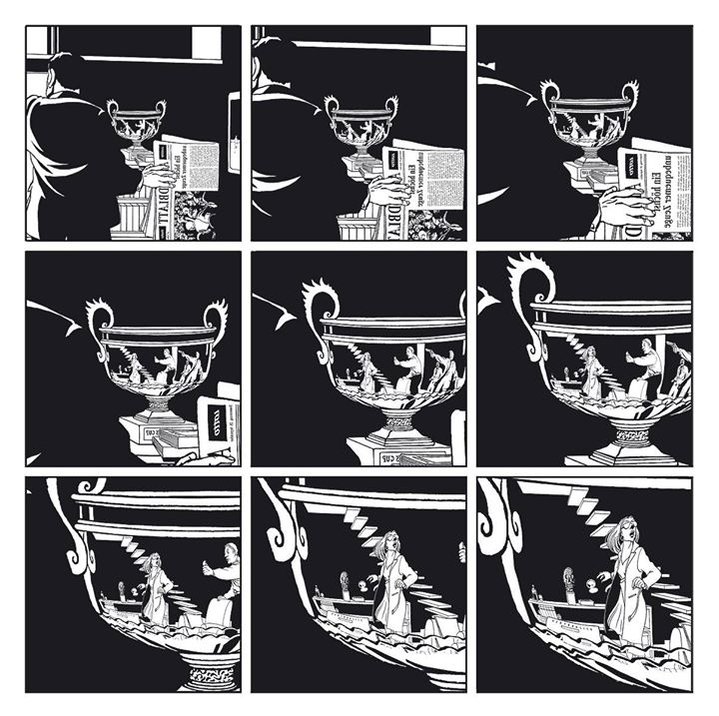A note on INK BABEL
March 20, 2017In the book Through the Vanishing Point, Marshall McLuhan and Harley Parker comment on the episodic imagery depicted on vases of ancient Greece. They write,
There is no point of view from which to look at a vase. The viewer can begin or end anywhere. The three-dimensional Greek figure stands stark on a single plane. The vase moves toward Euclidean space, but “Euclid alone hath looked on beauty bare.” 1 (quoted, Edna St. Vincent Millay)
The traditional format of the grecian vase organizes figures in sequence, set against the continual topological surface of the cylindrical vessel. This picture plane introduces many entry points for the viewer. A viewer can spin the vase around and around, replay the imagery or reverse it, but the entire image spans beyond the sight lines of what can viewed all at once.
When I first started thinking about making INK BABEL, I wanted to produce a work that was organized around the horizon line but a horizon that couldn’t be seen all at once. The horizon is the traveler’s storied crust. It is always just out of reach and is symbolically filled with potential stories, quests and sagas.
Conversely, towers are static and often associated with power. Originally INK BABEL depicted sequential views from the perspective of the viewer looking across the horizon from the top of a tower. The work would display the views from four towers, in four directions on four gallery walls, but the towers themselves would be invisible. Each tower would reflect some purpose related to fire, water, air and earth. The sequences of figures as one scans the vista from the towers would cascade down like film strips – an element that remains in INK BABEL presently. The true vanishing point was to be located within the viewer. But as the work emerged and decisions were committed to ink, external towers emerged on the landscape. They became points of information collection and dissemination, such as cell phone towers, lighthouses and watchtowers. I realized that the entire work was becoming a single tower.
The physicality of cells in a strip of film combined with the candy-cane like, external staircase depicted in Bruegel’s iconic 16th century paintings of the biblical Tower of Babel are only hinted at in the structure of INK BABEL. While contemplating the design of the work, I asked, “What can’t be depicted with film? What are the limits of a film?” Film is well-equipped as a language. It is a complex, nuanced and beautiful medium. It allows for a prism of techniques and perspectives, but it is historically bound to a strip in physical terms. INK BABEL is organized vertically like cinema filmstrip that has been allowed to spill out horizontally to form a grid, creating a bi-directional panorama. Cells in each vertical column display imagery that behaves like a pan-shot on a film strip, something I call “time dominant” cells, whereas the cells pulling out horizontally are “space dominant” panoramas, as one might see in still photography. This two-dimensional work operates more like Microfiche than the linear format of a cinema filmstrip. It has many entry points and locates the vanishing plane along an endless horizon line.
How do you organize a landscape on a 2D page? Are there cultural rules or biases for organizing a page? Do we depict land and water top-down as in an arial map, complete with imaginary lines of territories and domains? Complete with earthwork drawings of empires? However you organize them, landscapes are bizarre, dreamlike hallucinations. I roll out a welcome mat to a disjointed landscape, an unlikely topology, but aren’t they all.
1. McLuhan, Marshall, and Harley Parker. Through the Vanishing Point; Space in Poetry and Painting. New York: Harper & Row, 1968. 43. Print.



